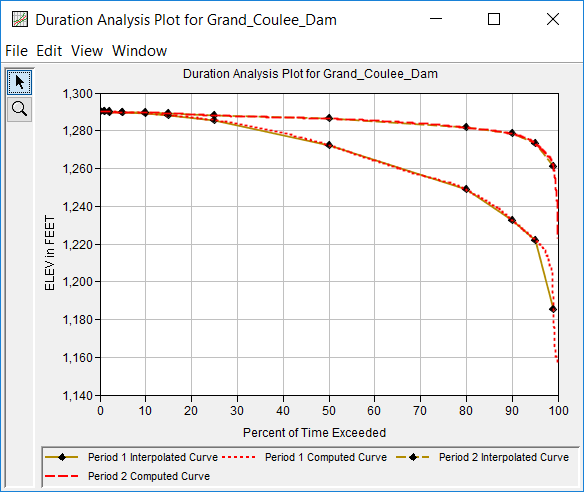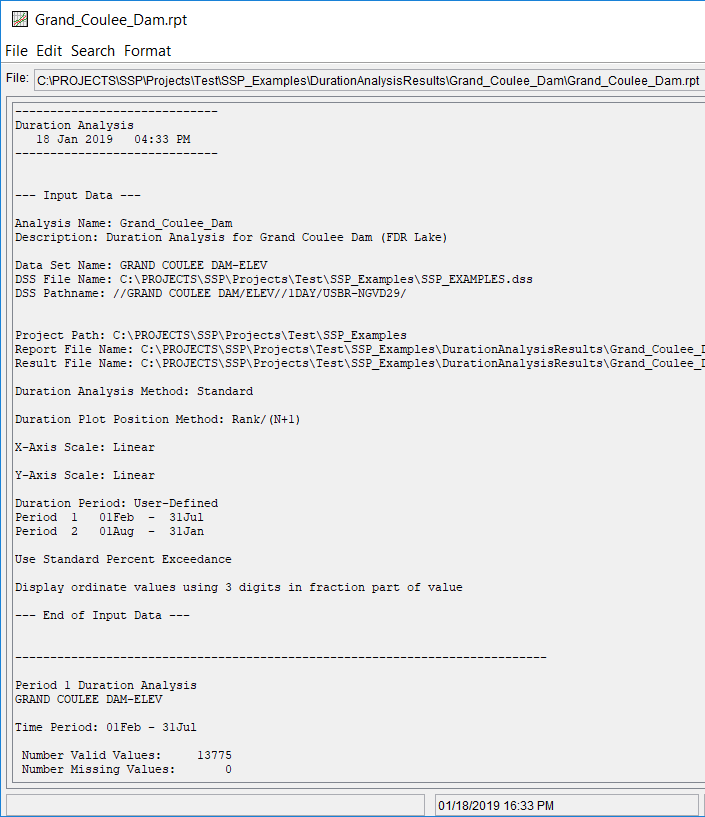The user can view output for the duration analysis directly from the Duration Analysis editor (Tabular and Graphical output) or by using the buttons at the bottom of the editor. Results can also be opened by selecting the duration analysis in the study explorer and then choosing the Graph, Table, or Report option available from the Results menu.
Tabular Output
Once the computations for the duration analysis are completed, the user can view tabular output by selecting the Tabular Results tab under the Results tab. The details of this table were discussed above.
The tabular results can be printed by using the Print button at the bottom of the Duration Analysis editor. When the print button is pressed, a window will appear giving the user options for how they would like the table to be printed.
Graphical Output
Graphical output of the duration curve can be obtained by selecting either the Plot tab under the results tab, or by pressing the button labeled Plot Duration Curve at the bottom of the Duration Analysis editor. When the Plot Duration Curve button is pressed, a duration curve plot will appear in a separate window as shown in Figure 1.

The duration curve plot can be sent to the printer by selecting the Print option from the File menu at the top of the window. Additional printing options available from the File menu are Page Setup, Print Preview, and Print Multiple (used for printing multiple graphs on the same page). The graphic can also be sent to the Windows Clipboard by selecting Copy to Clipboard from the File menu. Additionally, the plot can be saved to a file by selecting the Save As option from the File menu. When the Save As option is selected, a window will appear allowing the user to select a directory, enter a filename, and select the format for saving the file. Currently, four file formats are available for saving the graphic to disk: windows metafile, postscript, JPEG, and portable network graphic.
The data contained within the plot can also be tabulated by selecting Tabulate from the File menu. When this option is selected, a separate window will appear with the data tabulated. Additional options are available from the File menu for saving the plot options as a template (Save Template) and applying previously saved templates to the current plot (Apply Template).
The Edit menu contains several options for customizing the graphic. These options include Plot Properties, Configure Plot Layout, Default Line Styles, and Default Plot Properties. Also, a shortcut menu will appear with further customizing options when the user right-clicks on a line on the graph or the legend. Both the Y and X-axis properties can be edited by placing the mouse on top of axis and clicking the right mouse button. Then select the Edit Properties menu option in the shortcut menu. For example, the user can turn on minor tic marks for the y-axis and modify the minimum and maximum scale for the x-axis. The graphic customizing capabilities within HEC-SSP are very powerful, but are also somewhat complex to use. The code used in developing the plots in HEC-SSP is the same code that is used for developing plots in HEC-DSSVue and several other HEC software programs. Please refer to the HEC-DSSVue User's Manual for details on customizing plots.
Viewing the Report File
A report file is created when the duration analysis computations are performed. The report file contains information about the duration analysis and the final results. To view the report file press the View Report button at the bottom of the Duration Analysis editor. When this button is pressed, a window will appear containing the report as shown in Figure 2.
